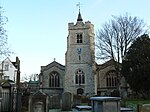St Alban's Church, Acton Green
19th-century Church of England church buildingsBuildings and structures in ChiswickChurch of England church buildings in the London Borough of EalingChurches completed in 1887Diocese of London ... and 2 more
English churches dedicated to St AlbanGothic Revival church buildings in London

St Alban's Church, Acton Green, also called St Alban the Martyr, is a church on South Parade, Acton Green in Chiswick, west London, designed by Edward Monson Jr. and opened in 1888.
Excerpt from the Wikipedia article St Alban's Church, Acton Green (License: CC BY-SA 3.0, Authors, Images).St Alban's Church, Acton Green
St. Albans Avenue, London Acton (London Borough of Ealing)
Geographical coordinates (GPS) Address External links Nearby Places Show on map
Geographical coordinates (GPS)
| Latitude | Longitude |
|---|---|
| N 51.495833333333 ° | E -0.26305555555556 ° |
Address
St Alban
St. Albans Avenue
W4 5JS London, Acton (London Borough of Ealing)
England, United Kingdom
Open on Google Maps









